Reviving a Neglected Crop: A Case Study on Lentil (Lens culinaris Medikus subsp. culinaris) Cultivation in Germany
Abstract
1. Introduction
2. Materials and Methods
2.1. Data Collection and Case Survey Design
2.2. Study Area
2.3. Study Parameters
- What were your reasons and motivations to start to cultivate lentils?
- Were there important persons/actors/organizations or institutions for you, that influenced or supported you in your decision to start lentil cultivation?
- What are your reasons and motivation to continue lentil cultivation up to now? Did it change or are there different reasons compared to the beginning?
- Do you exchange knowledge with others? Where do you get information about lentil cultivation?
- What problems do you have in lentil cultivation? What are the causes for it?
- What benefits and challenges do you see while working together as a producer cooperative (if you are a member or a cooperative)?
- What challenges and possibilities do you see for lentil cultivation in the future? If you had a wish concerning lentil farming, what would it be?
- Attractive challenge
- Public perception
- Processing facilities available
- Effects on the environment and society
- External triggers
- Agricultural potential of lentils
- Marketing channels
2.4. Statistical Analysis and Data Visualization
3. Results
3.1. Farm Inventory
3.2. Lentil Varieties
3.3. Sowing Date and Harvest Date
3.4. Effects of Lentil Variety and Crop Management on Lentil Yield
3.5. Yield of Companion Crop and Effects of Companion Crop on Lentil Yield
3.6. Mixing Ratio between Lentils and Companion Crops
3.7. Soil Tillage
3.8. Weeds
3.9. Crop Rotation, Preceding Crops, Subsequent Crops, and Catch Crops
3.10. Evaluation of the Face-to-Face Interviews
4. Discussion
5. Conclusions
Author Contributions
Funding
Institutional Review Board Statement
Informed Consent Statement
Data Availability Statement
Acknowledgments
Conflicts of Interest
References
- Vasconcelos, M.W.; Balázs, B.; Kelemen, E.; Squire, G.R.; Iannetta, P.P.M. Editorial: Transitions to sustainable food and feed systems. Front. Plant Sci. 2019, 10. [Google Scholar] [CrossRef] [PubMed]
- Squire, G.R.; Quesada, N.; Begg, G.S.; Iannetta, P.P.M. Transitions to greater legume inclusion in cropland: Defining opportunities and estimating benefits for the nitrogen economy. Food Energy Secur. 2019, 8. [Google Scholar] [CrossRef]
- Cokkizgin, A.; Shtaya, M.J.Y. Lentil: Origin, cultivation techniques, utilization and advances in transformation. Agric. Sci. 2013, 1, 55–62. [Google Scholar] [CrossRef]
- Sarker, A.; Erskine, W. Recent progress in the ancient lentil. J. Agric. Sci. 2006, 144, 19–29. [Google Scholar] [CrossRef]
- Santos, C.S.; Silva, B.; Valente, L.M.P.; Gruber, S.; Vasconcelos, M.W. The effect of sprouting in lentil (Lens culinaris) nutritional and microbiological profile. Foods 2020, 9, 400. [Google Scholar] [CrossRef]
- Urbano, G.; Porres, J.M.; Frías, J.; Vidal-Valverde, C. Nutritional value. In Lentil: An Ancient Crop for Modern Times; Yadav, S.S., McNeil, D.L., Stevenson, P.C., Eds.; Springer: Dordrecht, The Netherlands, 2007; pp. 47–93. [Google Scholar]
- Yadav, S.S.; Stevenson, P.C.; Rizvi, A.H.; Manohar, M.; Gailing, S.; Mateljan, G. Use and consumption. In Lentil: An Ancient Crop for Modern Times; Yadav, S.S., McNeil, D.L., Stevenson, P.C., Eds.; Springer: Dordrecht, The Netherlands, 2007; pp. 33–46. [Google Scholar]
- Food and Agriculture Organization of the United Nations. FAOSTAT. Available online: http://www.fao.org/faostat/en/#data/QC (accessed on 9 December 2020).
- Horneburg, B.; Becker, H.C. Crop adaptation in on-farm management by natural and conscious selection: A case study with lentil. Crop Sci. 2008, 48, 203–212. [Google Scholar] [CrossRef]
- Horneburg, B. Frischer Wind für eine Alte Kulturpflanze! Linsen im Ökologischen Anbau, ihre Geschichte und Verwendung. Mit Hinweisen zur Sortenpflege und Sortenentwicklung im Landwirtschaftlichen Betrieb, 1st ed.; Dreschflegel e.V.: Göttingen, Germany, 2003. [Google Scholar]
- Güll, R. Die Linse—Renaissance Einer Hülsenfrucht in Baden-Württemberg. Available online: https://www.statistik-bw.de/Service/Veroeff/Monatshefte/PDF/Beitrag14_12_05.pdf (accessed on 29 October 2020).
- Chemnitz, C.; Rehmer, C.; Wenz, K. Fleischatlas 2018: Daten und Fakten über Tiere als Nahrungsmittel. Available online: https://www.bund.net/service/publikationen/detail/publication/fleischatlas-2018/ (accessed on 8 December 2020).
- Bundesministerium für Ernährung und Landwirtschaft. Deutschland, wie es isst: Der BMEL-Ernährungsreport 2020. Available online: https://www.bmel.de/SharedDocs/Downloads/DE/Broschueren/ernaehrungsreport-2020.html;jsessionid=82627DC07C3C92F31A52E8E7C8F40969.internet2832 (accessed on 8 December 2020).
- Ministerium für Ländlichen Raum und Verbraucherschutz Baden-Württemberg. Linsen-Info: Anbauregionen. Available online: https://linsen.landwirtschaft-bw.de/pb/,Lde/Startseite/Anbau+und+Verarbeitung/Anbauregionen (accessed on 30 October 2020).
- Wang, L.; Gruber, S.; Claupein, W. Optimizing lentil-based mixed cropping with different companion crops and plant densities in terms of crop yield and weed control. Org. Agr. 2012, 2, 79–87. [Google Scholar] [CrossRef]
- Carr, P.M.; Gardner, J.J.; Schatz, B.G.; Zwinger, S.W.; Guldan, S.J. Grain yield and weed biomass of a wheat–lentil intercrop. Agron. J. 1995, 87, 574–579. [Google Scholar] [CrossRef]
- Mammel, L. Lauteracher Alb-Feld-Früchte: Erzeuger Gemeinschaft. Available online: https://lauteracher.de/oeko-erzeugergemeinschaft-alb-leisa/ (accessed on 30 October 2020).
- Landeszentrale für Politische Bildung Baden-Württemberg. Landeskunde Baden-Württemberg: Die Regionalverbände. Available online: https://www.landeskunde-baden-wuerttemberg.de/regionalverbaende.html (accessed on 29 October 2020).
- Landesanstalt für Umwelt Baden-Württemberg. Klimawandel und Anpassung-Boden: Hintergrund und Eckdaten. Available online: https://www.lubw.baden-wuerttemberg.de/klimawandel-und-anpassung/boden-hintergrund-und-eckdaten (accessed on 30 October 2020).
- Landwirtschaftliches Technologiezentrum Augustenberg. Agrarmeteorologie Baden-Württemberg. Available online: https://www.wetter-bw.de/Internet/AM/inetcntrBW.nsf/cuhome.xsp?src=DXA7X04V99&p1=7IN3BW78X7&p3=0SUH35YG92&p4=EZ5D5ZTI3K (accessed on 29 October 2020).
- Crowley, J.G.; Fröhlich, A. Factors Affecting the Composition and Use of Camelina; Teagasc: Dublin, Ireland, 1998. [Google Scholar]
- Maurer, A.; Draba, V.; Pillen, K. Genomic dissection of plant development and its impact on thousand grain weight in barley through nested association mapping. J. Exp. Bot. 2016, 67, 2507–2518. [Google Scholar] [CrossRef]
- Mut, Z.; Erbaş Kose, Ö.D.; Akay, H. Grain yield and some quality traits of different oat (Avena sativa L.) genotypes. Int. J. Environ. Agric. Res. 2016, 2, 83–88. [Google Scholar]
- Mayring, P. Qualitative Inhaltsanalyse. Grundlagen und Techniken, 12th ed.; Beltz Verlagsgruppe: Weinheim, Germany, 2010. [Google Scholar]
- Patterson, H.D. Analysis of series of variety trials. In Statistical Methods for Plant Variety Evaluation, 1st ed.; Kempton, R.A., Fox, P.N., Cerezo, M., Eds.; Springer: Dordrecht, The Netherlands, 1997; pp. 139–161. [Google Scholar]
- Wolfinger, R. Covariance structure selection in general mixed models. Commun. Stat. Simul. Comput. 1993, 22, 1079–1106. [Google Scholar] [CrossRef]
- Kuntze, H.; Niemann, J.; Roeschmann, G.; Schwerdtfeger, G. Bodenkunde, 4th ed.; Ulmer Press: Stuttgart, Germany, 1989. [Google Scholar]
- Bundesministeriums der Justiz und für Verbraucherschutz. Gesetz zur Schätzung des Landwirtschaftlichen Kulturbodens (Bodenschätzungsgesetz–BodSchätzG). Available online: https://www.gesetze-im-internet.de/bodsch_tzg_2008/BodSch%C3%A4tzG.pdf (accessed on 21 December 2020).
- Wang, L.; Gruber, S.; Claupein, W. Mixed cropping with lentils increases grain protein of wheat and barley. J. Cultiv. Plants 2013, 65, 422–426. [Google Scholar] [CrossRef]
- Vlachostergios, D.N.; Roupakias, D.G. Response to conventional and organic environment of thirty-six lentil (Lens culinaris Medik.) varieties. Euphytica 2008, 163, 449–457. [Google Scholar] [CrossRef]
- Siddique, K.H.M.; Loss, S.P.; Regan, K.L.; Pritchard, D.L. Adaptation of lentil (Lens culinaris Medik) to short season Mediterranean-type environments: Response to sowing rates. Aust. J. Agric. Res. 1998, 49, 1057–1066. [Google Scholar] [CrossRef]
- Baird, J.M.; Shirtliffe, S.J.; Walley, F.L. Optimal seeding rate for organic production of lentil in the northern Great Plains. Can. J. Plant Sci. 2009, 89, 1089–1097. [Google Scholar] [CrossRef]
- Bundesanstalt für Landwirtschaft und Ernährung. Erträge im Biologischen und Konventionellen Landbau. Available online: https://www.oekolandbau.de/handel/marktinformationen/der-biomarkt/marktberichte/ertraege-im-biologischen-und-konventionellen-landbau/ (accessed on 8 December 2020).
- Seufert, V.; Ramankutty, N.; Foley, J.A. Comparing the yields of organic and conventional agriculture. Nature 2012, 485, 229–232. [Google Scholar] [CrossRef]
- Pimentel, D.; Hepperly, P.; Hanson, J.; Douds, D.; Seidel, R. Environmental, energetic, and economic comparisons of organic and conventional farming systems. BioScience 2005, 55, 574–582. [Google Scholar] [CrossRef]
- Hawkes, J.G. 1. The importance of genetic resources in plant breeding. Biol. J. Linn. Soc. 1991, 43, 3–10. [Google Scholar] [CrossRef]
- Mammel, L. (Lauteracher Alb-Feld-Früchte, Lauterach, Germany); Mammel, W. (Lauteracher Alb-Feld-Früchte, Lauterach, Germany). Personal communication, 2017.
- Gruber, S.; Zikeli, S.; Claupein, W. Perspectives and limitations of weed control in organic lentils (Lens culinaris): A review. J. Cultiv. Plants 2012, 64, 365–377. [Google Scholar]
- Dierauer, H.; Kranzler, A.; Ebert, U. Creeping Thistle: Successful Control in Organic Farming; Basic Guide. Available online: https://www.agricology.co.uk/sites/default/files/Creeping%20Thistle.pdf (accessed on 7 November 2020).
- Pelzer, E.; Bourlet, C.; Carlsson, G.; Lopez-Bellido, R.J.; Jensen, E.S.; Jeuffroy, M.-H. Design, assessment and feasibility of legume-based cropping systems in three European regions. Crop Pasture Sci. 2017, 68, 902. [Google Scholar] [CrossRef]
- Bundesministerium für Ernährung und Landwirtschaft. Agrarpolitischer Bericht der Bundesregierung 2019. Available online: https://www.bmel-statistik.de/landwirtschaft/agrarpolitischer-bericht/ (accessed on 23 November 2020).
- Statistisches Bundesamt Bodennutzungshaupterhebung. Ökologischer Landbaunach Verordnung (EG) Nr. 834/2007 i.V.m. Verordnung (EG) Nr. 889/2008 in Deutschland im Jahr 2019. Available online: https://www.bmel.de/SharedDocs/Downloads/DE/_Landwirtschaft/Biologischer-Landbau/oekolandbau-deutschland-2019.pdf?__blob=publicationFile&v=2 (accessed on 8 December 2020).
- Zander, K.; Hamm, U. Werte ökologischer Lebensmittel: Anforderungen an eine erfolgreiche Kommunikation mit Verbrauchern. In Es geht ums Ganze: Forschen im Dialog von Wissenschaft und Praxis, Proceedings of the Wissenschaftstagung Ökologischer Landbau, Gießen, Germany, 15–18 March 2011; Leithold, G., Becker, K., Brock, C., Fischinger, S., Spiegel, A.-K., Spory, K., Wilbois, K.-P., Williges, U., Eds.; Dr. Köster: Berlin, Germany; pp. 292–295.
- Askegaard, S.; Madsen, T.K. The local and the global: Exploring traits of homogeneity and heterogeneity in European food cultures. Int. Bus. Rev. 1998, 7, 549–568. [Google Scholar] [CrossRef]
- Clarkson, J. Food History Almanac. Over 1,300 Years of World Culinary History, Culture, and Social Influence; Rowman & Littlefield Publishers: Lanham, MD, USA, 2013. [Google Scholar]
- Mestre, J.-R. La Lentille Verte du Puy. Une Histoire Naturelle! Ed. du Roure: Polignac, France, 2009. [Google Scholar]
- Piergiovanni, A.R. The evolution of lentil (Lens culinaris Medik.) cultivation in Italy and its effects on the survival of autochthonous populations. Genet. Resour. Crop Evol. 2000, 47, 305–314. [Google Scholar] [CrossRef]

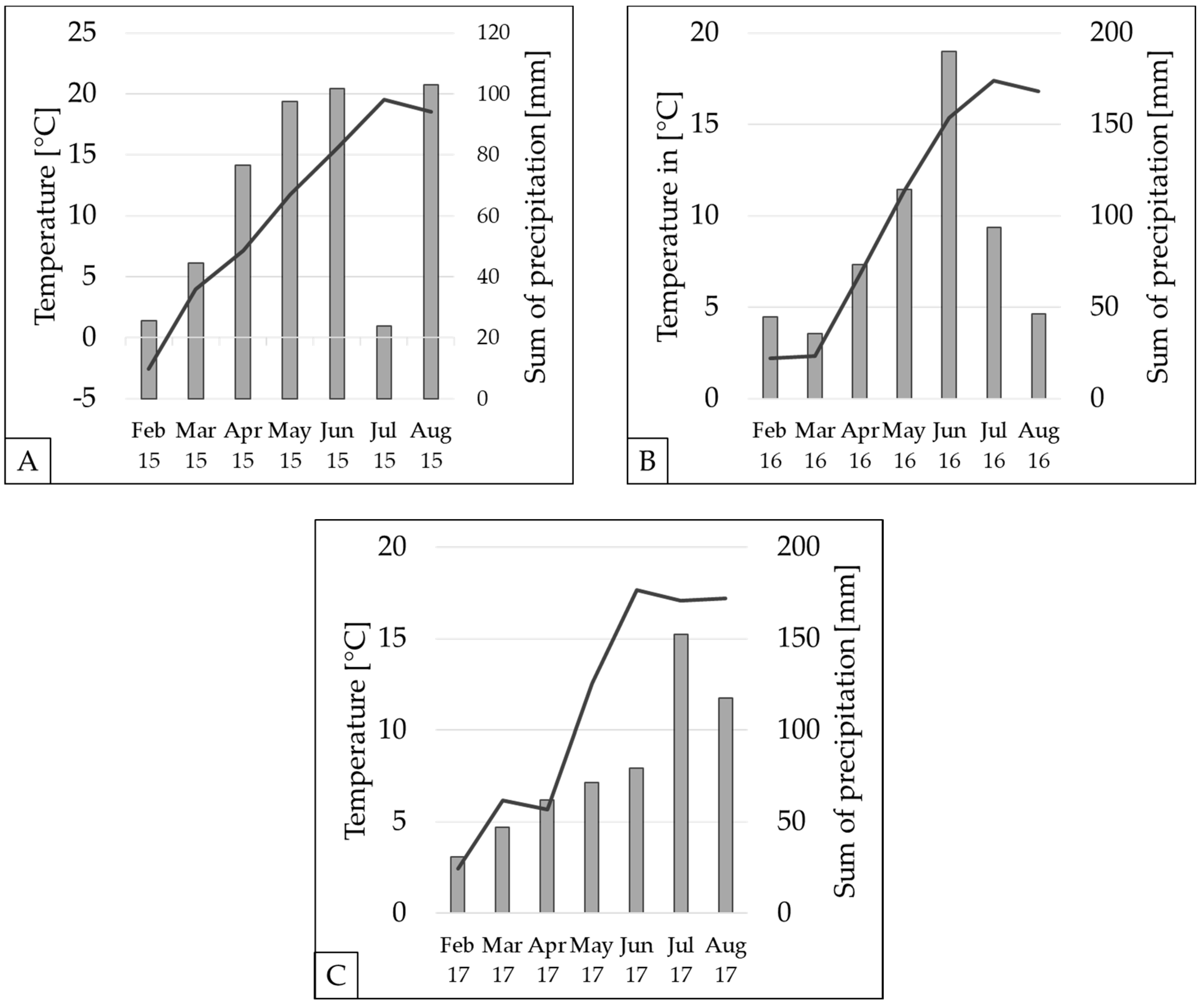

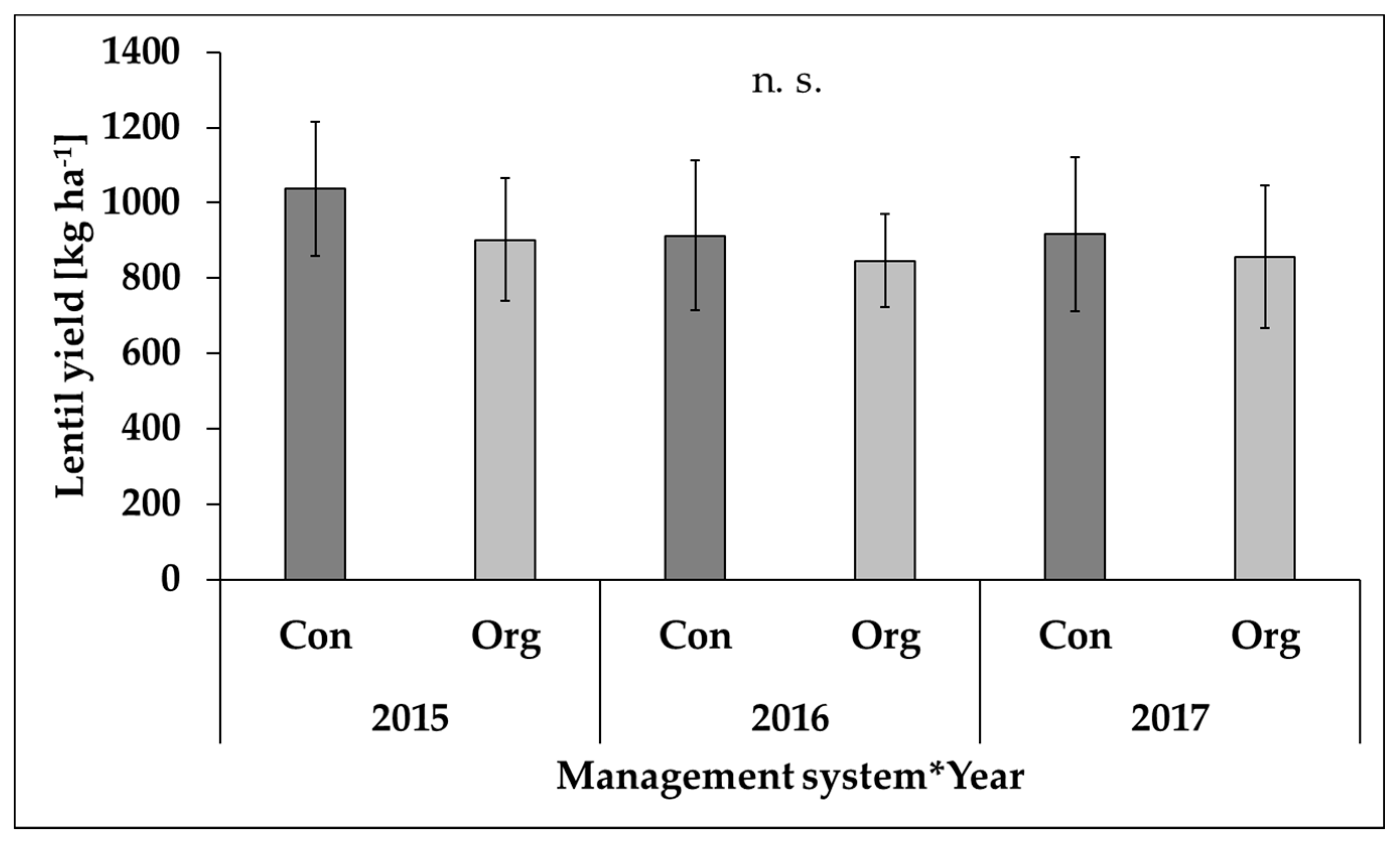
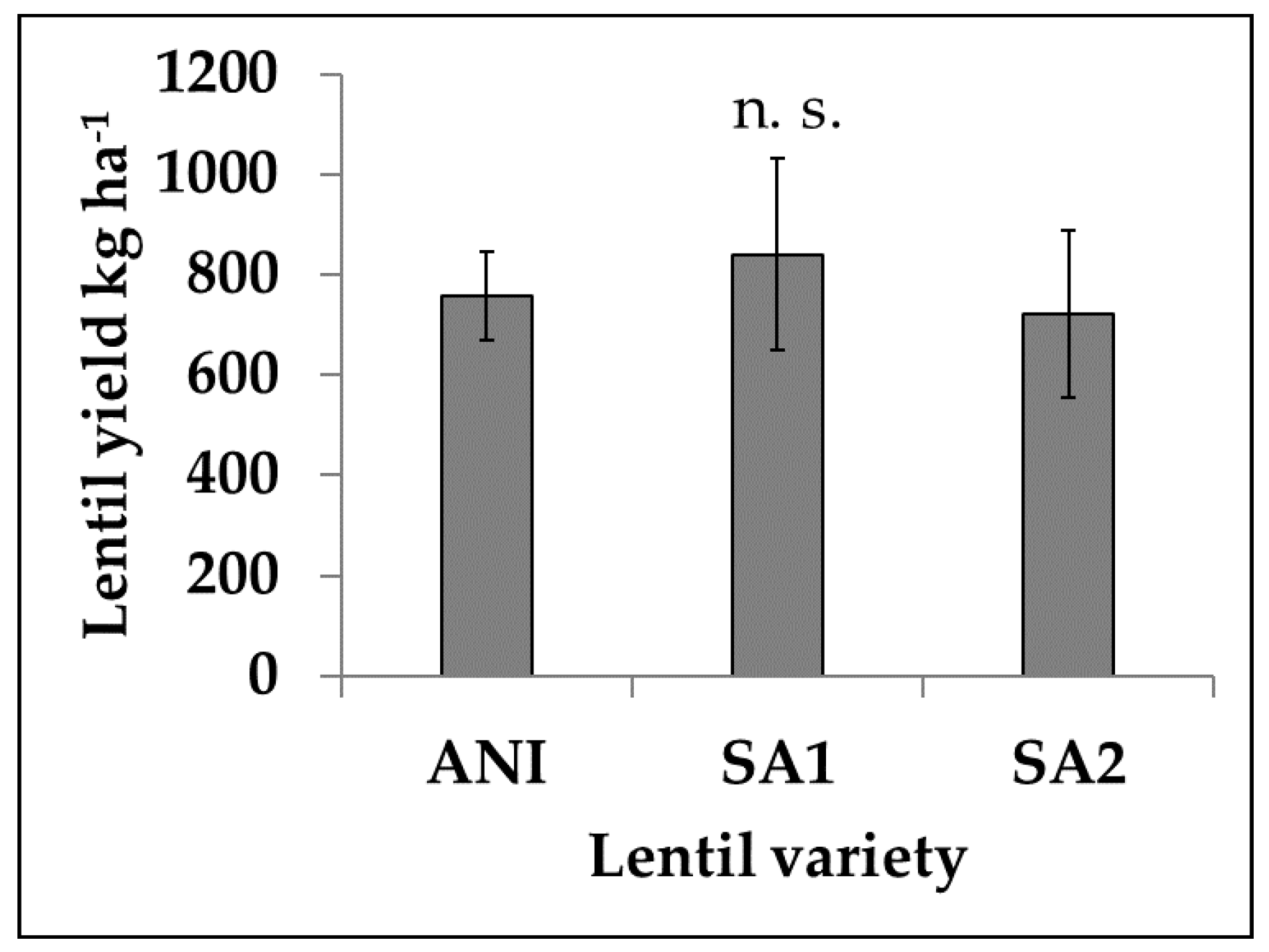
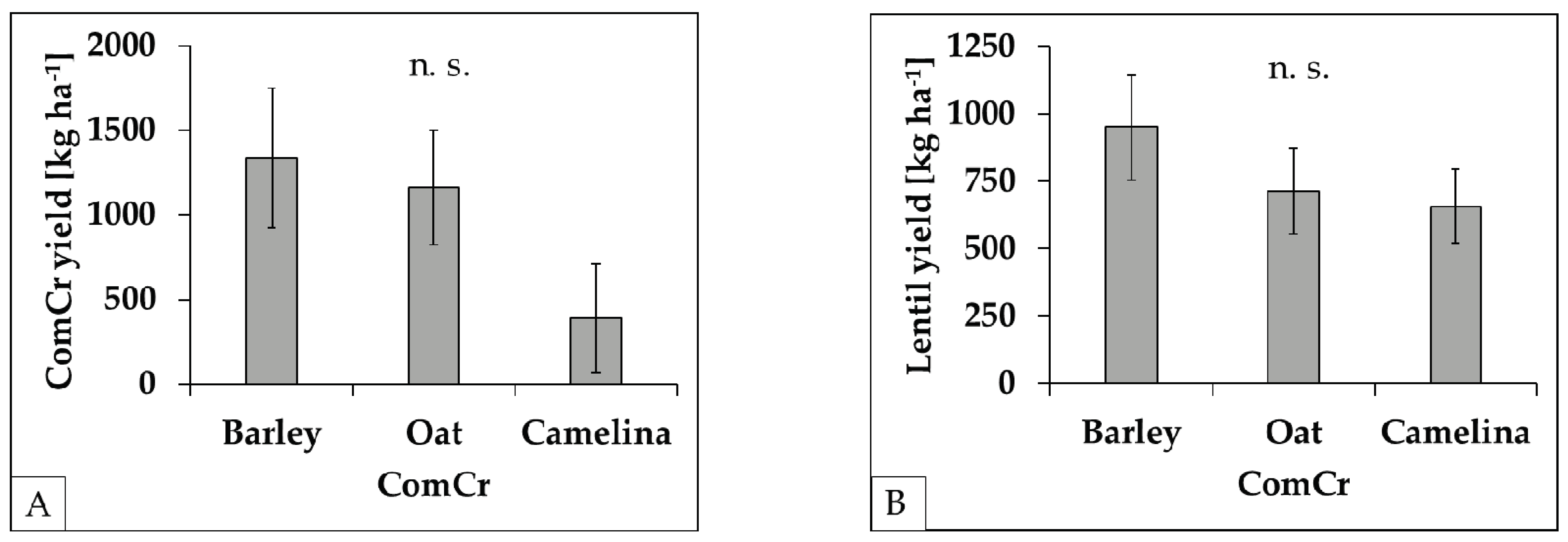
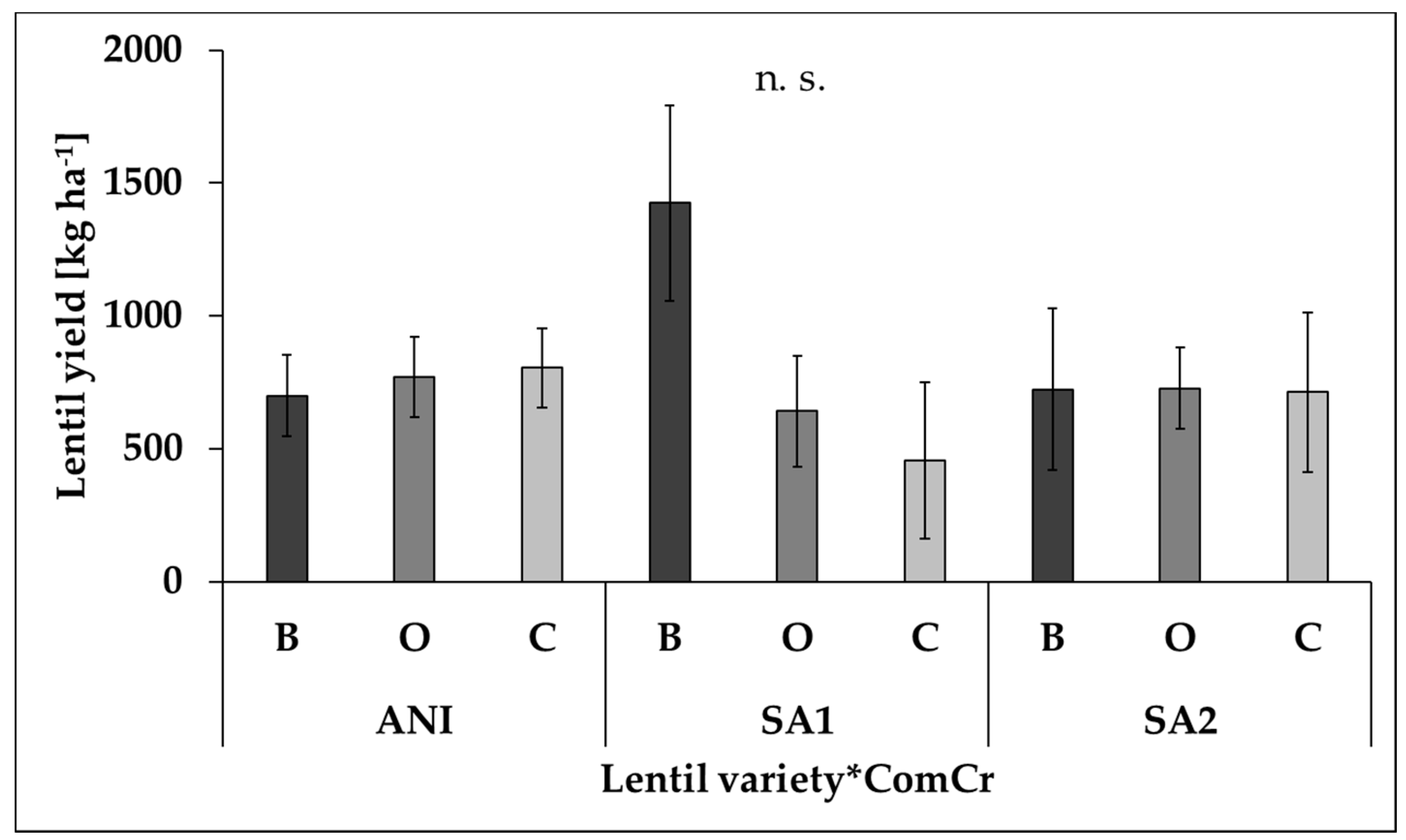
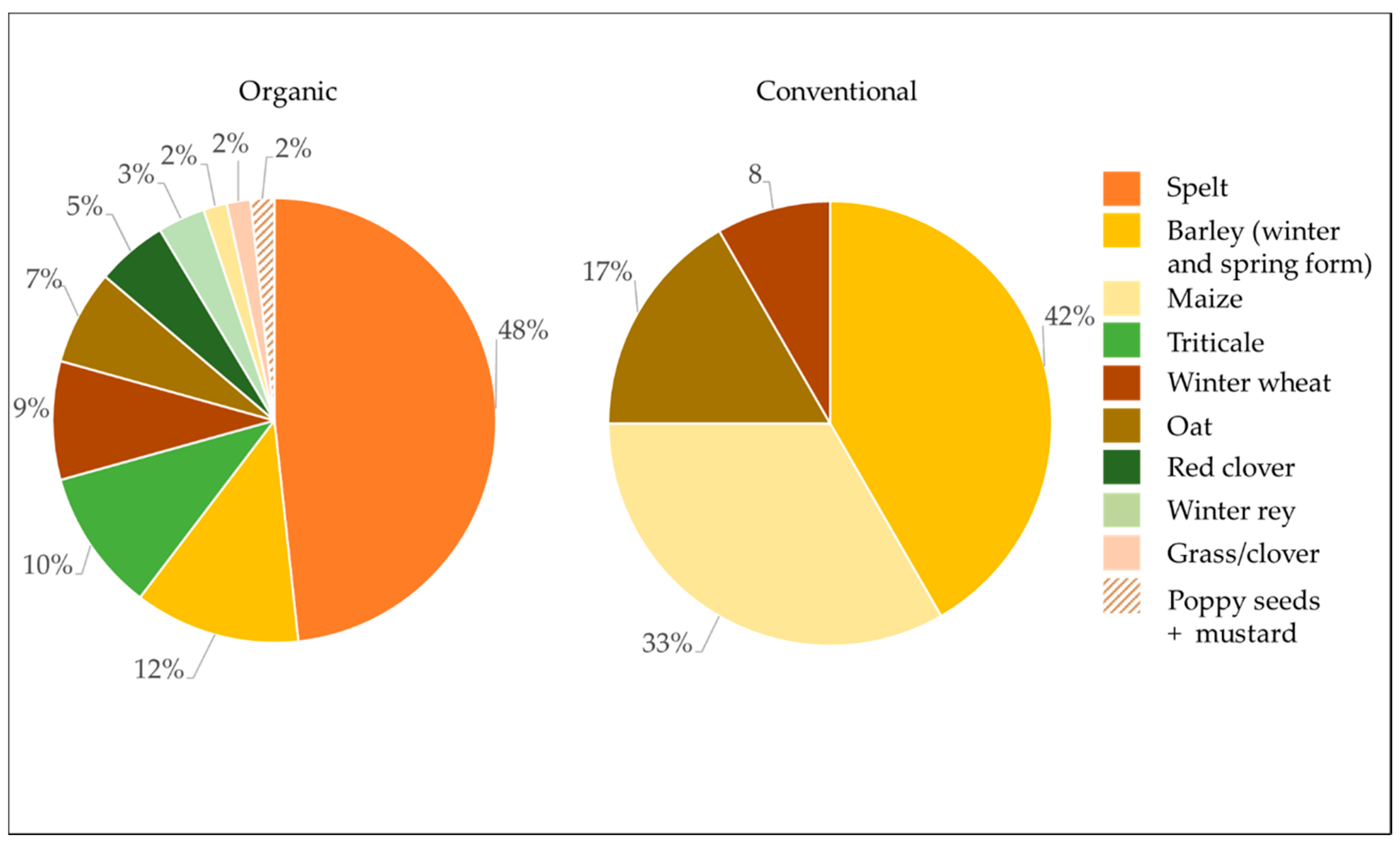
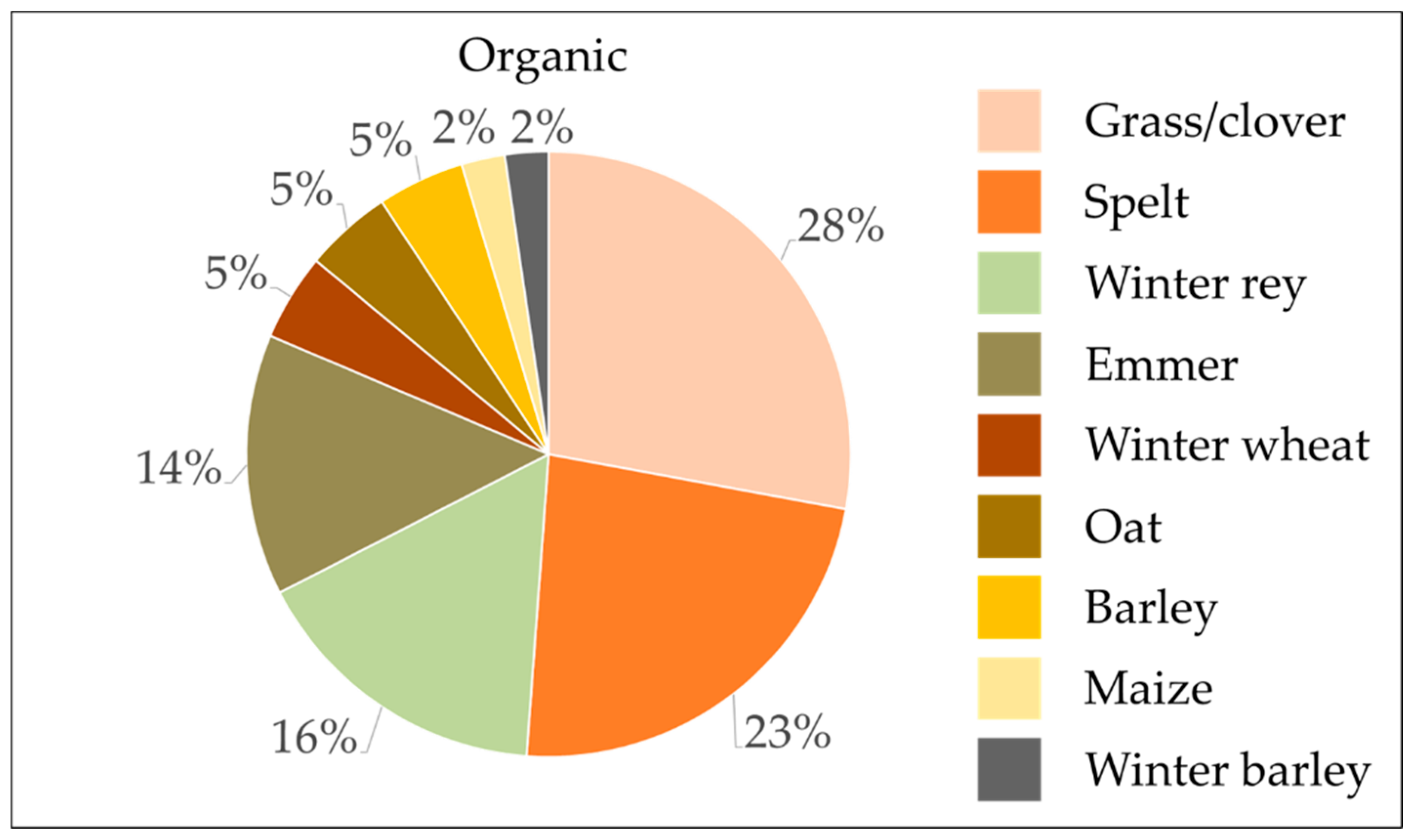
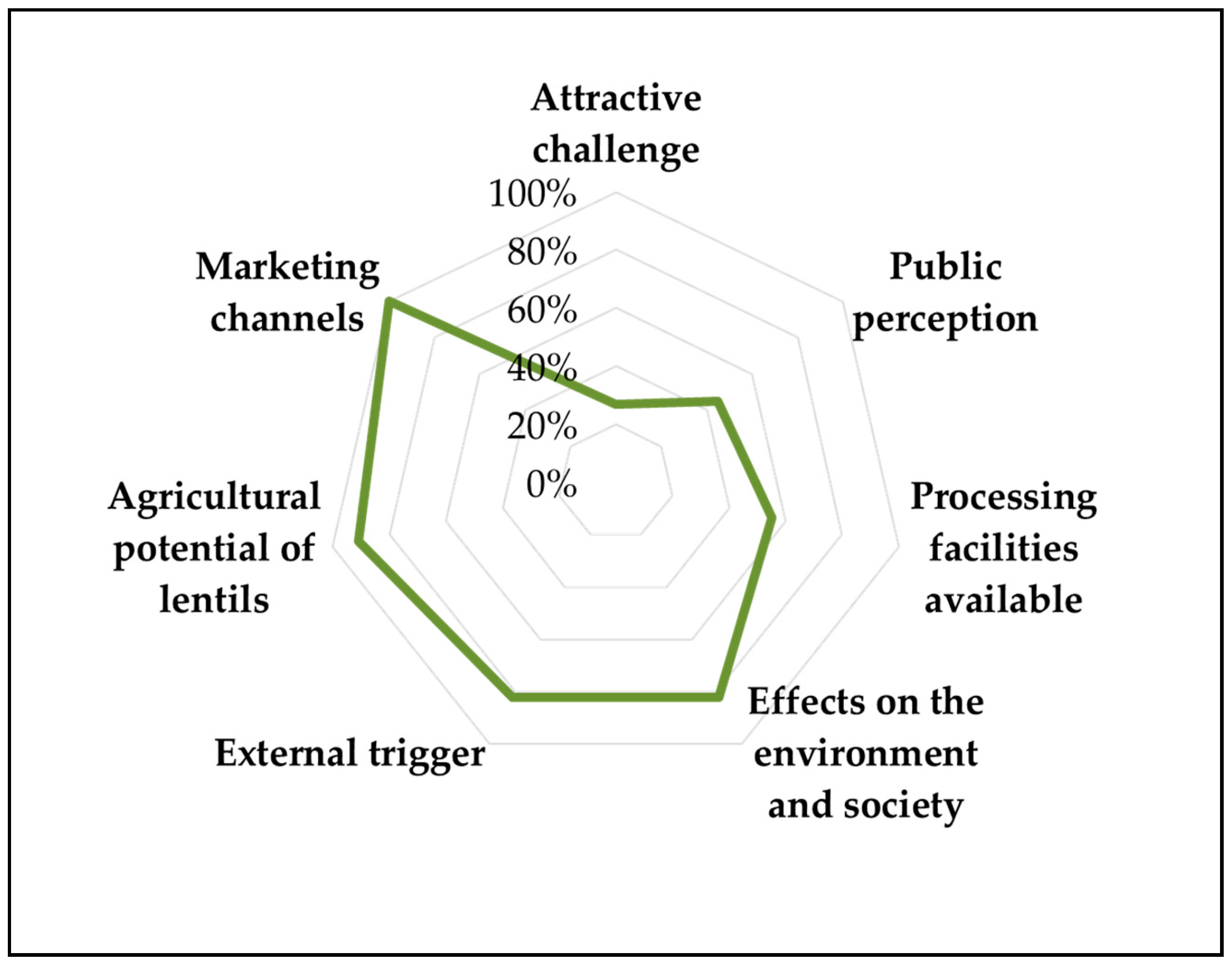
| Site/ District | 1 | 2 | 3 | 4 | 5 | 6 | 7 | 8 | 9 |
|---|---|---|---|---|---|---|---|---|---|
| Location weather station | N 48.38° E 9.95° | N 48.11° E 9.77° | N 48.74° E 8.92° | N 48.60° E 10.15° | N 48.94° E 8.50° | N 48.88° E 9.20° | N 48.47° E 9.30° | N 48.02° E 9.26° | N 48.53° E 8.98° |
| Altitude (m ASL *) | 552 | 590 | 475 | 550 | 273 | 296 | 720 | 619 | 439 |
| Geology | lime-stone marl and white Jurassic | Pleistocene gravel terraces | Lias/ Keuper cuestas | lime-stone marl and white Jurassic | river sediments of the upper rhine limestone | Lias/ Keuper cuestas | lime-stone marl and white Jurassic | Pleistocene gravel terraces | Lias/ Keuper cuestas |
| Annual precipitation Ø [mm] | |||||||||
| 2014 | 210 | 655 | 763 | 503 | 774 | 641 | n.a. * | 706 | 645 |
| 2015 | 590 | 778 | 545 | 516 | 672 | 553 | 710 | 663 | 503 |
| 2016 | 735 | 888 | 647 | 711 | 792 | 690 | 779 | 880 | 696 |
| 2017 | n.a. * | 846 | 634 | 844 | 732 | 773 | 817 | 804 | 768 |
| 2018 | 565 | 717 | 526 | 595 | 681 | 603 | 612 | 680 | 470 |
| Annual temperature Ø [°C] | |||||||||
| 2014 | 7.7 | 9.7 | 10.4 | 8.7 | 11.9 | 12.0 | 8.5 | 9.4 | 11.4 |
| 2015 | 9.0 | 9.4 | 10.2 | 8.9 | 11.7 | 11.7 | 8.9 | 9.1 | 11.3 |
| 2016 | 8.5 | 8.7 | 9.1 | 8.7 | 11.0 | 10.9 | 8.5 | 8.7 | 10.4 |
| 2017 | 8.5 | 8.8 | 9.2 | 8.7 | 11.3 | 11.2 | 8.3 | 8.7 | 10.6 |
| 2018 | 9.4 | 9.7 | 10.2 | 9.7 | 12.0 | 12.5 | 9.1 | 9.6 | 11.6 |
| Farm Data | Cultivation Data | ||
|---|---|---|---|
| Variable | Results/Category (Unit) | Variable | Results/Category (Unit) |
| Farm size | metric (ha) | lentil (Lens culinaris Medik. subsp. culinaris) variety | Anicia, Späth’s Alblinse I, Späth’s Alblinse II |
| Type of management | organic, conventional | species of companion crop | spelt (Triticum spelta L.) 1, spring barley (Hordeum vulgare L.), oat (Avena sativa L.), camelina (Camelina sativa L.) |
| Livestock | stockless, dairy cows, suckler cows, bulls, horses, others | mixing ratio between sowing ratio lentil and companion crop | ((kglentil ha−1)/(kgcompanion crop ha−1)) categorized into groups (Table 3) |
| Average annual temperature | metric (°C) | preceding crop in crop rotation | qualitative listing |
| Annual average precipitation | metric (mm) | tillage | use of moldboard plough, no use of moldboard plough |
| Soil quality ranking | metric | ||
| Soil texture | clayey loam, silt loam, sandy loam, loamy clay | ||
| Average pH value | metric | ||
| Group | Description | Grain Number Lentil m−2 per Grain Number Companion Crop m−2 |
|---|---|---|
| 1 | Companion crop highly dominating | <0.5 |
| 2 | Companion crop slightly dominating | 0.5 to <1 |
| 3 | Lentil slightly dominating | 1 to <2 |
| 4 | Lentil moderately dominating | 2 to <3 |
| 5 | Lentil highly dominating | ≥3 |
| Lentil Varieties | Organic Farms | Conventional Farms |
|---|---|---|
| 2015 | Anicia (n = 11) Späth’s Alblinse I (n = 2) Späth’s Alblinse II (n = 6) | Anicia (n = 4) |
| 2016 | Anicia (n = 8) Späth’s Alblinse I (n = 2) Späth’s Alblinse II (n = 9) | Anicia (n = 4) |
| 2017 | Anicia (n = 7) Späth’s Alblinse I (n = 4) Späth’s Alblinse II (n = 9) | Anicia (n = 4) |
| Companion crop | ||
| 2015 | camelina (n = 3) oat (n = 8) spring barley (n = 8) | camelina (n = 3) |
| 2016 | camelina (n = 2) oat (n = 11) spring barley (n = 7) | camelina (n = 3) oat (n = 1) |
| 2017 | camelina (n = 3) oat (n = 11) spelt (n = 1) spring barley (n = 5) | camelina (n = 2) oat (n = 1) spring barley (n = 1) |
| Organic | Conventional | Total | |
|---|---|---|---|
| Conventional tillage | n = 16 | n = 3 | n = 19 (76%) |
| Reduced tillage | n = 5 | n = 1 | n = 6 (24%) |
Publisher’s Note: MDPI stays neutral with regard to jurisdictional claims in published maps and institutional affiliations. |
© 2020 by the authors. Licensee MDPI, Basel, Switzerland. This article is an open access article distributed under the terms and conditions of the Creative Commons Attribution (CC BY) license (http://creativecommons.org/licenses/by/4.0/).
Share and Cite
Reif, T.M.; Zikeli, S.; Rieps, A.-M.; Lang, C.P.; Hartung, J.; Gruber, S. Reviving a Neglected Crop: A Case Study on Lentil (Lens culinaris Medikus subsp. culinaris) Cultivation in Germany. Sustainability 2021, 13, 133. https://doi.org/10.3390/su13010133
Reif TM, Zikeli S, Rieps A-M, Lang CP, Hartung J, Gruber S. Reviving a Neglected Crop: A Case Study on Lentil (Lens culinaris Medikus subsp. culinaris) Cultivation in Germany. Sustainability. 2021; 13(1):133. https://doi.org/10.3390/su13010133
Chicago/Turabian StyleReif, Theresa M., Sabine Zikeli, Ann-Marleen Rieps, Carina P. Lang, Jens Hartung, and Sabine Gruber. 2021. "Reviving a Neglected Crop: A Case Study on Lentil (Lens culinaris Medikus subsp. culinaris) Cultivation in Germany" Sustainability 13, no. 1: 133. https://doi.org/10.3390/su13010133
APA StyleReif, T. M., Zikeli, S., Rieps, A.-M., Lang, C. P., Hartung, J., & Gruber, S. (2021). Reviving a Neglected Crop: A Case Study on Lentil (Lens culinaris Medikus subsp. culinaris) Cultivation in Germany. Sustainability, 13(1), 133. https://doi.org/10.3390/su13010133




